#Ptolemy Philadelphus
Text
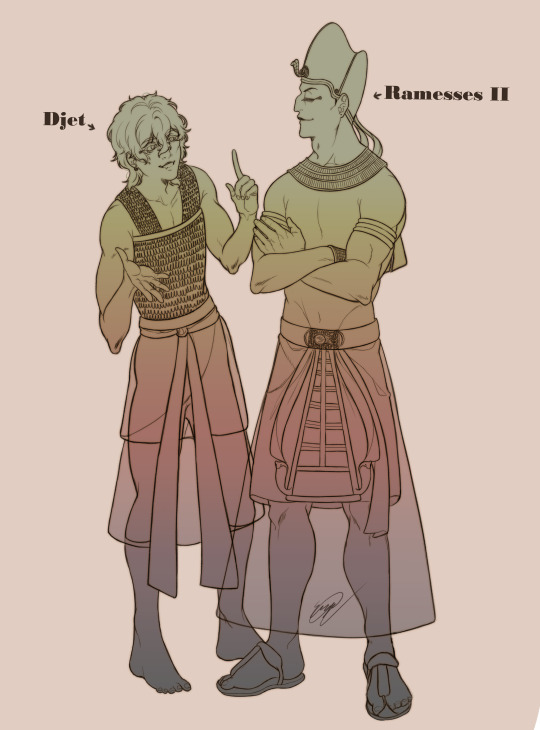









My webcomic characters ft. the historical characters they were close to!
#webcomic#ancient history#ancient egypt#amasis#ramesses ii#ptolemaic egypt#ancient rome#republican rome#cleopatra#mark antony#pharaonic egypt#ptolemy philadelphus#imperial rome#cleopatra selene ii#alexander helios#cleopatra vii#ptolemy xv#caesarion#the gracchi#tiberius sempronius gracchus#gaius sempronius gracchus#cornelia#hadrian#antinous#djet#khawy#iaret/chloe#sempronia#lucius#the followers of the divine snake
30 notes
·
View notes
Text
Roman Theater, Souks, Eid al-Fitr Amman Jordan

View On WordPress
#Amman Citadel#Amman Farmers Market#Bedouin Craftsman#Bedouin Tents#Egyptian Pharaoh Cleopatra VII of the Ptolemaic Dynasty#Eid al-Fitr Festival of Breaking the Fast#I&039;tikaf#Jabal Al-Jofah#Jordan Folklore Museum#Jordanian Museum of Popular Traditions#Nour al Barakah#Philadelphia Capital of the Roman Empire#Ptolemy Philadelphus#Ramadan#Roman Amphitheater Amman#Roman Emperor Antoninus Pius#Roman Triumvir Mark Antony#Souk el-Khodra#Souk el-Sagha#Souk Jara#Souk Mango
0 notes
Photo
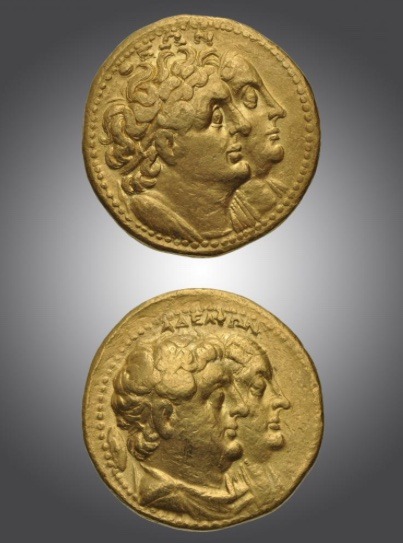
Greek Coin - Gold Octodrachm of Ptolemy II Philadelphus
C. 265-246 BC
Ø 2.8 cm
Obverse: busts of Ptolemy II and Arsinoe II with a Gallic shield behind. Reverse: Ptolemy I and Berenike I.
#Greek Coin - Gold Octodrachm of Ptolemy II Philadelphus#C. 265-246 BC#gold#gold coins#collectable coins#ancient artifacts#archeology#archeolgst#history#history news#ancient history#ancient culture#ancient civilizations#ancient greece#greek history#greek art
175 notes
·
View notes
Text

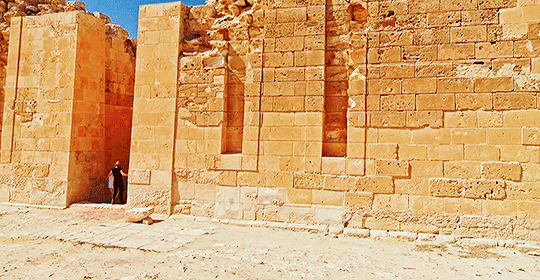
ANCIENT EGYPT BY TRAIN (2023) — 1.01 Alexandria
Taposiris Magna is a city established by Pharaoh Ptolemy II Philadelphus between 280 and 270 BCE. The name means "great tomb of Osiris", which Plutarch identifies with an Egyptian temple in the city.
#egypt#ancient egypt#egyptology#archaeology#historyedit#documentary#gifsbyancientegyptdaily#doc: ancient egypt by train#alexandria#taposiris magna#2023
176 notes
·
View notes
Text

On this day in history, August 12th, two thousand and fifty three years ago, Cleopatra VII, the last active ruler of Ancient Egypt, committed suicide.
Eleven days previously, her husband Marc Antony had already done the same. The couple had been engaged in a civil war against Octavian, the great nephew of Julius Caesar who had been declared his legal heir. During the final battle in Alexandria, Antony suffered serious desertions among his troops and lost the fight. Upon his return, he falsely heard Cleopatra had killed herself and fell on his sword.
After Antony’s death, Octavian arrived in Egypt and effectively took Cleopatra and her children by Antony prisoner. She had sent her eldest son Caesarion, her only living child with Caesar, away for his own safety. She knew that Octavian planned for her to march in chains behind his chariot during his triumph parade, and would very likely have her killed afterwards. Rather than suffer such humiliations and indignity, she chose to take her own life.
Popular history and mythology leads us to believe that she was killed by inducing an asp to bite her, after having locked herself in her mausoleum with her two handmaidens. However, many modern scholars believe that she instead took a mixture of poisons, since the venom of an asp does not cause a quick or painless death. Octavian and his men found her too late to do anything, Cleopatra was already dead and one handmaiden, Iras, was nearly dead on the floor. The second, Charmian, was straightening the Queen’s diadem. According to legend, one of the men asked if this was well done of her mistress, and she shot back “Very well done, as befitting the descendant of so many noble Kings,“ before collapsing and dying herself.
Upon her death, Octavian honoured Cleopatra’s wish to be buried in her mausoleum at Antony’s side. He took her children with Antony, the twins Cleopatra Selene and Alexander Helios, along with their younger brother, Ptolemy Philadelphus, to Rome with him as prisoners of sorts. They were fated to march in his triumph parade in their mother’s place, the chains so heavy they could hardly walk. After this they were given to Octavian’s sister Octavia, who had been Antony’s third wife, to look after.
Cleopatra’s son with Caesar, Caesarion, was nominally sole ruler of Egypt after his mother’s death. Eleven days after her suicide, he was found after being lured back to Alxeandria under false pretenses of being allowed to rule in his mother’s place. Octavian ordered his murder, on advice that “Two Caesar were too many.”
With Cleopatra’s death, and Caesarion’s subsequent murder, the rule of the Ptolemaic Dynasty came to an end and Egypt became a mere Roman Province.
75 notes
·
View notes
Photo

Gonzaga Cameo of Ptolemy II Philadelphus and Arsinoe II. 19th.century. Auguste Gaspard Louis Boucher Desnoyers French 1779–1857. etching. http://hadrian6.tumblr.com
.
111 notes
·
View notes
Text
Sculpture of Antony and Cleopatra's twin babies

A Sculpture that has been idling in a museum for ages. Egyptologist Giuseppina Capriotti of the Italian National Research Council believes a statue in the Cairo Museum depicts the twin children of Mark Antony and Cleopatra, Alexander Helios and Cleopatra Selene. The sandstone statue was discovered near the temple of Hathor in Dendera on the west bank of the Nile in 1918. Cleopatra VII is known to have commissioned works in that temple, most famously a monumental pharaonic relief of herself and her son by Julius Caesar, Ptolemy XV Philopator Philometor Caesar, aka Caesarion.
The Cairo Museum bought the five-foot-tall statue but didn’t pay it a great deal of attention, thinking it a representation of the twin gods Shu and Tefnet, son and daughter of the sun god Atum-Ra.

The statue is of two nude children, one male, one female, who bear the attributes of sun and moon respectively. They have an arm over each other’s shoulders while they hold a serpent in their other hands. The coils of two snakes wind around their legs and the base of the statue.
Capriotti noticed that the boy has a sun-disc on his head, while the girl boasts a crescent and a lunar disc. The serpents, perhaps two cobras, would also be different forms of sun and moon, she said. Both discs are decorated with the udjat-eye, also called the eye of Horus, a common symbol in Egyptian art.
“Unfortunately, the faces are not well preserved, but we can see that the boy has curly hair and a braid on the right side of the head, typical of Egyptian children. The girl’s hair is arranged in a way similar to the so-called melonenfrisur (melon coiffure) an elaborated hairstyle often associated with the Ptolemaic dynasty, and Cleopatra particularly,” said Capriotti.
The statue dates to between 50 and 30 B.C. Mark Antony and Cleopatra’s twins were born in 40 B.C. so the timing fits, but it’s the unusual iconographic choices which suggest this is not just a statue of Shu and Tefnet. In the Egyptian pantheon, Tefnet, the sister, wears the solar disk, but in this piece the female twin wears the crescent moon and the male wears the sun, in keeping with the Greek tradition of the female moon goddess Selene and the male incarnation of the sun, Helios.
The twins’ embrace could suggest a solar eclipse, which is significant because when Mark Antony officially recognized the twins as his children three years after their birth, the event was marked by a solar eclipse. That’s when Cleopatra changed their names from plain Cleopatra and Alexander to Cleopatra Selene and Alexander Helios.
If these are Antony and Cleopatra’s twins, it’s the first representation of the two together ever discovered. The only other image we have is of an adult Cleopatra Selene on coins minted during her reign as Queen of Mauretania. Alexander Helios does not appear to have survived into adulthood, nor his younger brother Ptolemy Philadelphus.
After their parents’ suicides, all three of Antony’s children by Cleopatra were taken to Rome by Octavian in 30 B.C. to march in his triumph as royal captives in gold chains. He handed the three of them over to his sister Octavia, Antony’s third wife, to raise. The boys disappear from the historical record, perhaps dead at Augustus’ hand. Cleopatra Selene, on the other hand, was married around 20 B.C. to King Juba of Mauretania, a north African client state.
#alexander helios#cleopatra selene#mark antony#marcus antonius#cleopatra#cleopatra vii#antony and cleopatra#ancient egypt#rome#cairo egyptian museum#art history#ptolemaic egypt#ptolemaic dynasty#history
14 notes
·
View notes
Photo

Ptolemy II Philadelphus
Ptolemy II Philadelphus ("The Sibling Loving", r. 282-246 BCE) was the second ruler of the Ptolemaic Dynasty. He consolidated the kingdom conquered by his father Ptolemy I and presided over its golden age. Ptolemy II invested heavily in Alexandria, overseeing the completion of the Library of Alexandria and the Lighthouse of Alexandria, one of the Seven Wonders of the Ancient World.
Continue reading...
56 notes
·
View notes
Text
When Cleopatra VII and Mark Anthony closed their eyes for the last time, passing through to their longed-for afterlife, among the successors were their three orphans: Alexander Helios, Cleopatra Selene II, and Ptolemy Philadelphus. The one who finally became ambassador of the testimony of the powerful couple was Cleopatra Selene, whose son became the character of the last episode of the famous family of Ptolemies.
25 notes
·
View notes
Text
Some more stuff about the Asterix Hillbilly AU ( which mainly focuses on the Caesaris gens in that AU ) :
. When Caesarion was nearly 3 and about to go to kindergarten, Caesar was stabbed to death by a bunch of his executives AND BRUTUS
. It soon resulted everybody in the Caesaris gens to literally fight over who gets to take chief control of Caesar's landowning enterprise for 2 whole years ( which includes Cleopatra dragging EVERYONE who killed Caesar through the mud in multiple ways, Cleopatra VII managing to get some help from Mark Antony and Lepidus' households, Brutus and Porcia gets thrown to jail, several car crashes ensues, Cleopatra making Servilia go completely destitute and toss her into some asylum in the Carribean )
. Anyway at that point when Caesar died, Octavian was a Harvard business student at those points. But he did help his mom in the whole fiasco of fighting over that landowning business lol
. Meanwhile, Mark Antony and Cleopatra began a years long affair akin to that of Richard Burton and Elizabeth Taylor. It was highlighted in the tabloids, they had a messy break up and Mark Antony married Octavia Lidia ( Octavian's 2nd older sister ) on a rebound. Then those 2 soon had a messy divorce and Mark Antony and Cleopatra VII got back together.
. Eventually it soon came to a point where , absolutely enraged at Mark Antony leaving Octavia Lidia, Octavian and Livia Drusilla ( who becomes a business lawyer and originally from London, and is Italian - British ) came to wrestle with Cleopatra VII over the control of that land owning business out of spite.
. On top of that, things are getting heated between Mark Antony and Cleopatra at that point....which eventually resulted in Mark Antony ended up dead in a violent bar fight in San Francisco on a business trip ( much to the dismay of his sibs )
. Realizing things are too dangerous for her kids ( and upon realizing the shocking twist that Mark Antony accidentally let out some of the landowning business secrets to some of Octavian's spies before he died ), Cleopatra and her 4 kids moved out to LA for their safety.
. Anyway, Octavian and Livia became new CEOs of that landowning enterprise. Unlike IRL, Cleopatra luckily DID NOT commit suicide and Caesarion and hisvhalf sibs get to stay with their mother
. Cleopatra never remarried after that - she chose to focus more on her kids ( similar case with Jackie Bouvier after Onassis died )
. Well, things did soon turn out generally hopeful for Caesarion and his siblings. Caesarion got into Stanford, becomes a car racing champion like his father once was, and aspires to found his own vehicle company ( and he eventually did it ).
. Alexander Helios eventually got into diplomacy and later on becomes a member of the US Embassy in Athens International Embassies
. Cleo Selene II got into social journalism and eventually becomes happily married to Juba II ( an oil enterprise heir from Marrakesh, Morocco ), whom she eventually meets in UCLA. They moved to Marrakesh together where they later on inherited that enterprise. And Cleo Selene II soon runs her own ladies' column
. Ptolemy Philadelphus once got contact with a serious fever. Unlike IRL, he did not die at a young age. Rather, he gradually recovers and later on becomes committed to a medical geared path. Eventually becomes a PHD Radiologist who often gives guest lectures to various universities.
. Cleopatra VII was under suicide watch for a whole year after the whole drama which caused Cleopatra and her kids to move to LA. Luckily, she gradually recovers and later on lives a semi retirement life where she continues to be socially active, attending and hosting events and running her cosmetic line and such.
5 notes
·
View notes
Text

Foundations of the Rotunda of Arsinoë (Arsinoëion) at the Sanctuary of the Great Gods (Samothrace, Greece), foregrounding the Aegean Sea
Arsinoë II, a Ptolemy, dedicated this structure, which is the largest covered round building in Greek antiquity. Following the death of her first husband, Lysimachus, Arsinoë returned to Egypt and married her half-brother, Ptolemy II Philadelphus.
#isaac.jpg#archaeology#classical archaeology#greek#samothrace#sanctuary of the great gods#queen arsinoe#arsinoeion
116 notes
·
View notes
Text

A ROMAN MARBLE BUST OF ALEXANDER HELIOS
CIRCA 1ST CENTURY A.D.
Alexander Helios (late 40 BC – unknown, but possibly between 29 and 25 BC) was a Ptolemaic prince and son of Pharaoh Cleopatra VII of the Ptolemaic dynasty and Roman triumvir Mark Antony. Alexander's fraternal twin sister was Cleopatra Selene II. Cleopatra named her son after Alexander the Great. His second name in Ancient Greek means "Sun"; this was the counterpart of his twin sister's second name Selene, meaning "Moon".
The fate of Alexander Helios is unknown. Plutarch, Cassius Dio and Suetonius state that Octavian killed Antony's son Marcus Antonius Antyllus and Cleopatra's son with Julius Caesar, Caesarion. The only further mention of Alexander Helios and Ptolemy Philadelphus comes from Cassius Dio, who states that when their sister Cleopatra Selene II married King Juba II, Octavian (then named Augustus) spared the lives of Alexander Helios and Ptolemy Philadelphus as a favor to the couple. After Helios arrived in Rome, he disappears from historical records.
#A ROMAN MARBLE BUST OF ALEXANDER HELIOS#CIRCA 1ST CENTURY A.D.#mark antony#cleopatra#marble#marble statue#marble sculpture#ancient artifacts#archeology#archeolgst#history#history news#ancient history#ancient culture#ancient civilizations#ancient rome#roman history#roman empire#roman art
130 notes
·
View notes
Photo
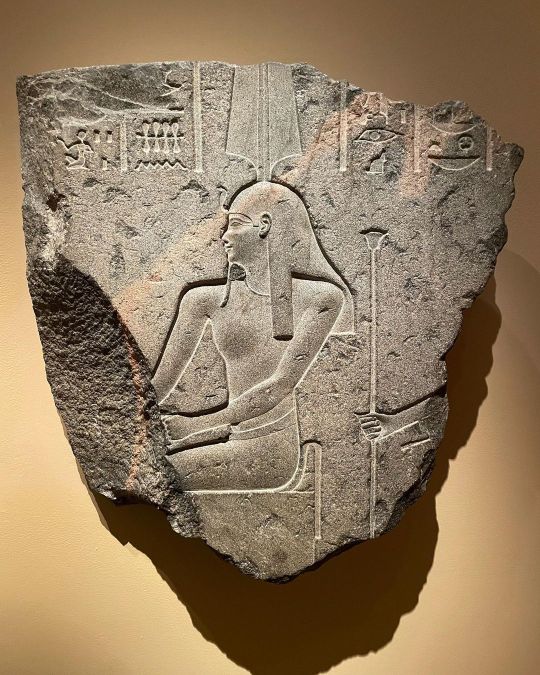
Seated God Probably Ptolemaic Period | 285-246 B.C. | Granite From Behbeit el Hagar In this relief, Osiris 𓁹𓊨 “wsir”, crowned with two plumes 𓆄𓅱𓏏𓆃 “šw.t”, is seated 𓈞𓊃𓀉 “ẖs” and followed by another seated divinity, possibly Isis 𓊨𓏏𓆇 “3s.t” whose scepter is visible. The block comes from the uppermost level of a wall 𓇋𓆛𓈖𓃀𓊊 “ı͗nb” where a series of seated gods 𓊹𓊹𓊹 “nṯrw” was represented. There is good reason to think this relief was carved during the reign of Ptolemy II (𓊪𓏏𓍯𓃭𓇌𓋴) “ptwlmys”‘Philadelphus’, the king 𓇓𓏏𓈖 “nsw” who completed the relief decoration of most of the temple 𓉞𓏏𓉐 “ḥw.t” proper. Despite the fact that their reigns are separated by sixty 𓎋 years 𓆳𓊪𓏏𓏤 “rnp.t”, the earliest Ptolemies chose to closely embrace the style of their predecessors of Dynasty 30. Only small details, such as the more relaxed smile and the exaggerated rounded pectoral muscle, seem to differentiate this block stylistically from the earlier block across the gallery. 𓋹𓎬𓋹𓎬𓋹𓎬𓋹𓎬𓋹𓎬𓋹𓎬𓋹𓎬𓋹𓎬𓋹𓎬𓋹𓎬𓋹𓎬𓋹𓎬𓋹𓎬𓋹𓎬𓋹𓎬𓋹𓎬 📸 @egyptologylessons 𓋹𓊽𓋴𓆖𓎛𓇳𓎛 © (@metmuseum and description) 𓊁𓊁𓊁𓊁𓊁𓊁𓊁𓊁𓊁𓊁𓊁𓊁𓊁𓊁𓊁𓊁𓊁 #Ancientegypt #ägypten #egyptianhistory #egyptology #hieroglyphs #egypte #egitto #埃及 #مصر #egipto #이집트 #relief #metropolitanmuseumofart #stonecarving (at The Metropolitan Museum of Art, New York) https://www.instagram.com/p/CeZNfMEO9Ml/?igshid=NGJjMDIxMWI=
#ancientegypt#ägypten#egyptianhistory#egyptology#hieroglyphs#egypte#egitto#埃及#مصر#egipto#이집트#relief#metropolitanmuseumofart#stonecarving
45 notes
·
View notes
Text
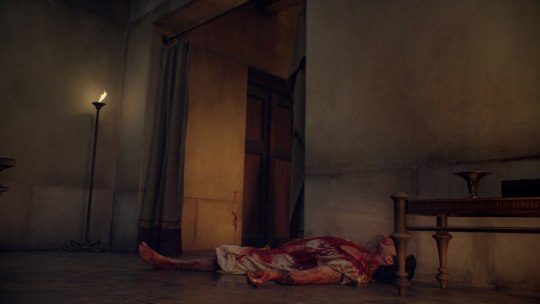


When Cleopatra took her own life, she left behind her four surviving children.
Her firstborn, and only living child with Caesar, Caesarion, did not live for long after her death. She had sent him away from Egypt for his own safety, but he was falsely lured back with promises of being allowed to rule in her place. He was murdered by Octavian’s men, after he’d received advice that “Too many Caesars is not good". As Caesar’s biological son, he was too much of a threat to Octavian’s rule. It’s thought he was likely killed by strangulation, but no one knows that for certain, or what happened to his body. He was 17 years old when he died, and had nominally been sole ruler of Egypt after his mother’s death.
It was a different story for her children with Mark Antony. There were the twins Cleopatra Selene II and Alexander Helios, who were both 9 at the time of their mother’s death, and Ptolemy Philadelphus, who was just 5 or 6. The three of them were taken to Rome by Octavian, and forced to walk behind his chariot in his Triumph Parade, attached to it with chains so heavy they could barely walk. This aroused not the scorn he’d been expecting, but sympathy for the poor young children. Octavian gave them to his sister Octavia, who had been married to their father, to be raised along with her children.
Neither of the boys would see adulthood, both apparently dying sometime before 25 B.C. There were rumours that Octavian had both of them killed, not wanting any adult sons of Antony and Cleopatra to remain alive.
Cleopatra Selene however, had a somewhat kinder fate. She was married to Juba II, King of Numidia and later Mauretania. She inherited the same strength and pride in her heritage of the Ptolemaic women that came before her, and used the same titles as her mother on coins. She had at least one child, a son she named Ptolemy, and possibly a daughter named Drusilla. Her exact date of death is unknown, but she was placed in the Royal Mausoleum of Mauretania when she died. It is still visible today, and a fragmentary inscription there is dedicated to Juba and Cleopatra, as the King and Queen of Mauretania.
#cleopatra#cleopatra vii#caesarion#cleopatra selene#cleopatra selene ii#alexander helios#ptolemy philadelphos#ptolemaic dynasty#long live the queue
27 notes
·
View notes
Text
Archaeologists have uncovered Greek full-colour portraits of mummies – the first to be found in 115 years – the Egyptian government has announced.
Researchers found the two full portraits of Egyptian mummies and fragments of others at the Gerza excavation site in Fayoum, making these artworks the first of their kind to be discovered in over 115 years.
English archaeologist Flinders Petrie was the last to find similar artwork when he discovered 146 mummy portraits at a Roman cemetery in 1911, Artnet News reports.
The findings are from a dig site located amid the ruins of the ancient city of Philadelphia, which according to the Austrian Archeological Institute, lies in the northeastern corner of Fayoum, approximately 75 miles southwest of modern-day Cairo.
The team investigating the Gerza archaeological site in Fayoum also uncovered a funerary building, records written on papyrus, pottery, and coffins dating from the Ptolemaic period, which spans from 305 B.C. to 30 B.C., through the Roman era, which lasted from 30 B.C. to 390 A.D.
The government has said these finds give fascinating insights into the social, economic, and religious conditions of the people living in Philadelphia (which meant, in ancient Greek, "City of Brotherly Love") nearly 2000 years ago.
The collection of paintings, known as the Fayoum portraits, portrays some of the wealthiest people that existed in these ancient communities. The Philadelphia settlement was home to Greeks and Egyptians over the 600-year period.
Basem Gehad, the head of the Ancient Philadelphia Excavation project, which led the latest dig, wrote in an email to Artnet News that "no one really knows the context of these portraits," but added, "Now, we can know certainly where they came from, and find more."
In addition to these finds, archaeologists also revealed a rare terracotta statue of the goddess Isis Aphrodite inside a wooden coffin, per Artnet.
Gehad told the news outlet the statue "reflects the influence of Greeks on Egyptian art as a result of [the] new community living there."
A statement from the Egyptian government explains that pharaoh Ptolemy II Philadelphus (309–246 B.C.) established Philadelphia as an agricultural village meant to secure further food resources for his empire.
Researchers have been digging at the site since 2016, according to the government.
2 notes
·
View notes
Text
„Twenty five years ago all that was known of Sotades’ notorious poem was a single line. This is a very infamous and highly offensive comment on Ptolemy’s marriage with his sister (fr. 1 Powell = Athen. 14.621a, [Plut.] De lib. ed. 11a; the translation of the following three fragments of Sotades and Callimachus is by Alan Cameron): εἰς οὐχ ὁσίην τρυµαλιὴν τὸ κέντρον ὤθει. partim ὤθει partim ὠθεῖ codd. Athen. ὠθεῖς De lib. ed. It’s an unholy hole he’s shoving his prick in. However, in 1984 Roberto Pretagostini came out with a proposal to see in this line a surprising ending of the poem which would begin with the verse in Sotadean metre that he found anonymously preserved in Hephaestion (fr. 16 Powell = Hephaest., p. 36.12 Consbruch): Ἥρην ποτέ φασιν ∆ία τὸν τερπικέραυνον… They say that once upon a time Zeus who delights in thunder and Hera… This line sounds like extracted from a fine encomium of the Ptolemies. One finds the same comparison of their marriage to the ἱερὸς γάµος of Zeus and Hera in Theocritus’ Encomium of Philadelphus (Id. 17.131–4), and we are told by Plutarch (Quaest. conv. 736f) that such was the beginning of an epithalamium sung by a certain rhapsode at the Ptolemies’ wedding. So, too, Sotades’ poem surely proceeded safely and predictably as a conventional wedding poem, until at the end the reader was unexpectedly attacked with the insult clearly addressed to the king.
Pretagostini’s ingenious reconstruction of the invective is widely (and rightly) accepted, and so is his suggestion that a certain passage in Callimachus’ Aetia should be viewed as an allusion to the poem of Sotades. The suspected passage of Callimachus is from the elegy Acontius and Cydippe. The context (lines 1–3 of the fragment) suggests that the narrator is about to tell the story of the ἱερὸς γάµος, but he suddenly cuts it short (Call., fr. 75.4–5 Pfeiffer = P. Oxy. 1011): Ἥρην γάρ κοτέ φασι – κύον, κύον, ἴσχεο, λαιδρὲ θυµέ, σύ γ' ἀείσῃ καὶ τά περ οὐχ ὁσίη. They say that once upon a time Hera– dog, dog, hold back, impudent soul! You would sing even what is not lawful. One clearly sees that the beginning of the story is an almost exact quotation of what we have just recognized as the first line of Sotades’ invective. In this light it can be plausibly argued that the expression οὐχ ὁσίη alludes to the analogous epithet in the abusive ending of Sotades’ poem.”
- Jan Kwapisz, A Lesson for the King: Sotades’ Invective against Ptolemy (fr. 1 and 16 Powell) and Callimachus’ “Epigram” 1 Pfeiffer.
0 notes